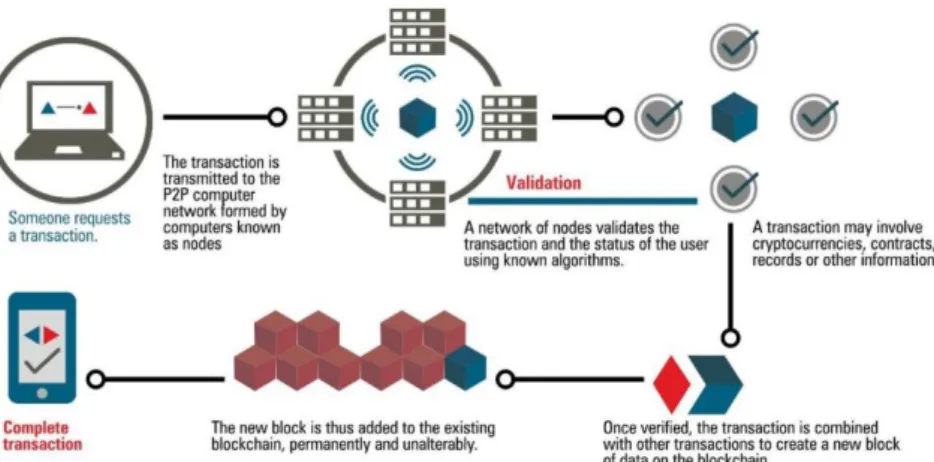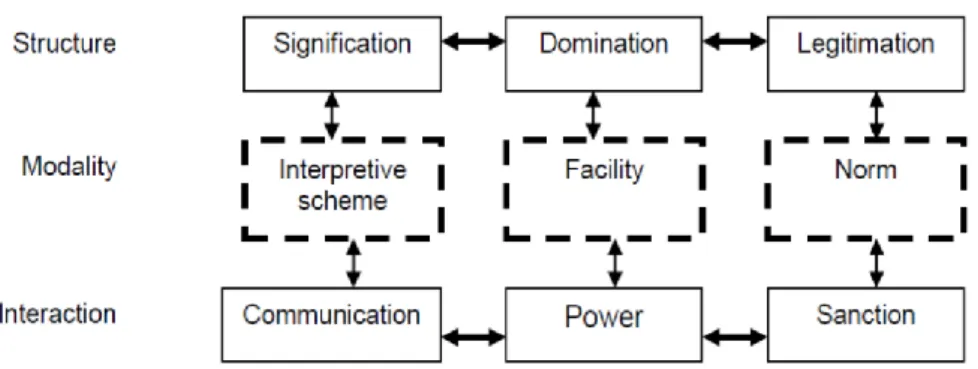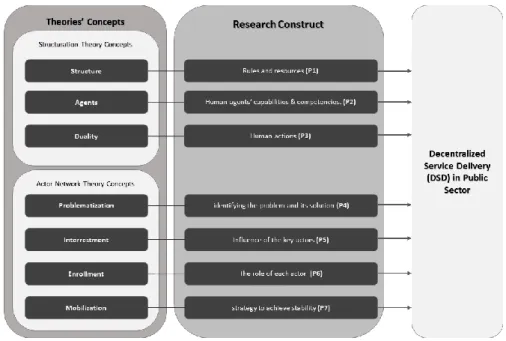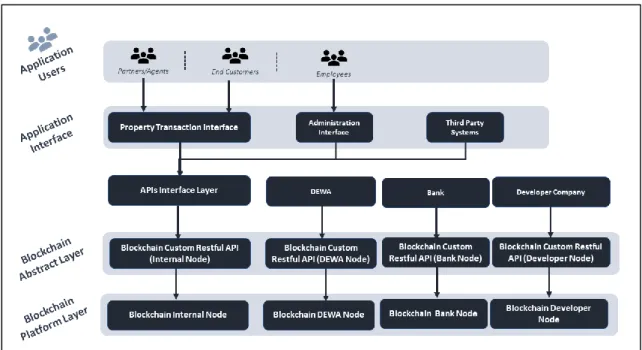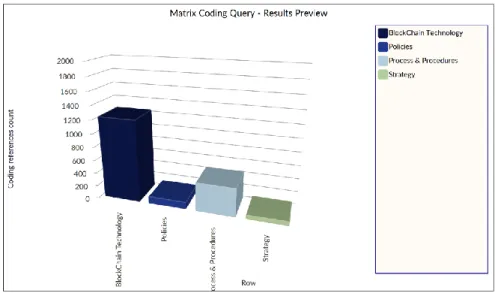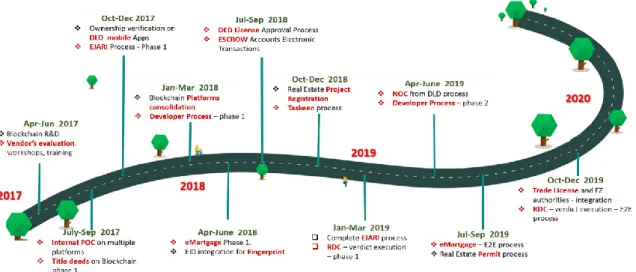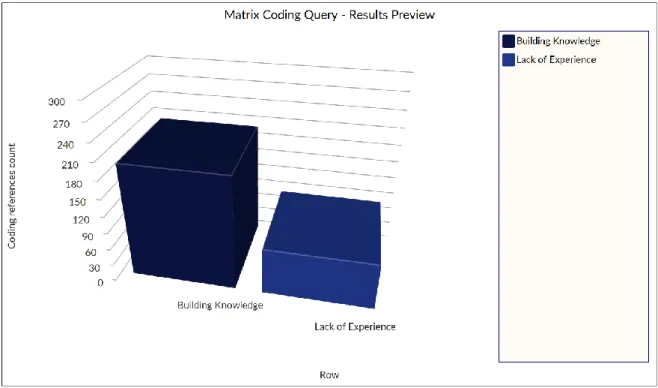The study integrated both theories to develop a framework to guide decentralized public sector e-service delivery and assist public sector decision makers to appropriately determine how Blockchain implementation can be achieved in both sustainable and scalable ways. Distributed Ledger Technology, Blockchain, Public Sector Service Delivery, Decentralized Public Sector Service, Structuration Theory, Actor-Network Theory.
INTRODUCTION
- Introduction
- Background of the research
- Justification of the research problem
- Significance of research
- Research Objectives
- Research Questions
- Theoretical Underpinning
- Scope of research
- Research Outline
2 To explore numerous challenges and institutional pressures related to the implementation of Blockchain Technology in the public sector. 2 What are the institutional pressures associated with the implementation of Blockchain Technology in the public sector.
OVERVIEW ABOUT BLOCKCHAIN
- What is Blockchain?
- Historical overview about Blockchain
- Benefits of the Blockchain
- Applications of Blockchain
- Automated Public Sector Service Delivery
- Challenges facing Public Sector services delivery
- Public Sector interest in Blockchain
- Adopting Blockchain for improving public sector services delivery
- Benefits for public sector services delivery by adopting Blockchain
- Barriers of Adopting Blockchain
- Decentralizing Public Sector Service delivery using Blockchain
- Introduction
- UAE Society
- UAE Economic Outlook
- UAE: the Political Context
- UAE: the Socio-Economic Development
- The Long-Term and Short-Term Goals of the UAE
- UAE Policy Issues Relating to Pandemic Diseases
- UAE Vision and Strategy towards Blockchain in the Public Sector
- Review of Digital Transformation and Blockchain implementation in the UAE Public
- Introduction
- Study Propositions
- Structuration Theory
- Structuration Theory overview
- Technology adoption Researchers using Structuration Theory
- Propositions informed by Structuration Theory concepts
- Actor Network Theory
- Actor Network Theory (ANT) overview
- Technology adoption Research based on ANT
- Propositions informed by Actor Network Theory concepts
- Summary
Furthermore, this study is about exploring the ways to improve the stability of the Blockchain solution after the start of the operational phase; nevertheless, a study of the appropriate support approach and cycle for operating Blockchain systems is not considered part of this study.
RESEARCH METHODOLOGY AND METHODS
Introduction
Choosing the best research method depends on how it relates to the research questions and problem (Avison et al. 1999). Therefore, this chapter explains the methodological stances of the research and provides rationales for the positioning of the research. Next, the research design section describes the unit of analysis and the selection of two cases for data collection.
Finally, this chapter explains how the study can address the expected challenge of quality and rigor that the researcher faces during the research process.
Ontology of the research
There are several research methods that can be used when it comes to technology acceptance research depending on the research objectives and contexts. As explained above, the aim of the research was to describe how the public sector can adopt distributed ledger technology to change and improve the quality of public sector service delivery, taking into account institutional and societal changes. Finally, this chapter elaborates on the selection of qualitative research methodology adopted in this research.
This research considers the investigation of the social phenomenon of how the network actors influence or influence the adoption of Blockchain technology in the public sector to improve public sector service delivery.
Epistemology of the research
On the other hand, subjectivism describes that the consequent actions of social actors and their perceptions produce social phenomena. This study is not intended to validate or criticize any aspect of Blockchain adoption. Rather, the main objective of this research is to explore and understand the perceptions of network actors or participants on the adoption of distributed ledger technology to improve the quality of public sector service delivery, including the contextual factors of the emergence of decentralized public sector services.
By doing so, as explained by Klein and Myers (1999), this study attempts to understand a moving target.
Research Methodology
Therefore, the researcher has adopted qualitative research methods, which remain the most suitable methods for this research in addition to the ontological and epistemological dimensions.
Research Strategy
Case Study Design
Number of case studies
Case Study Selection
The researcher faced many challenges while obtaining permission to conduct the case studies in these departments, which is a common challenge in similar research (Flower 1996). The researcher shared the objectives of this study with those helping with the implementation of Blockchain, in order to encourage these departments to give the researcher permission to conduct these case studies. Blockchain project key objective Bring end-to-end property processes on Blockchain to improve the scalability, security, transparency of public sector services and provide a distributed property data to all the participants of the trusted network.
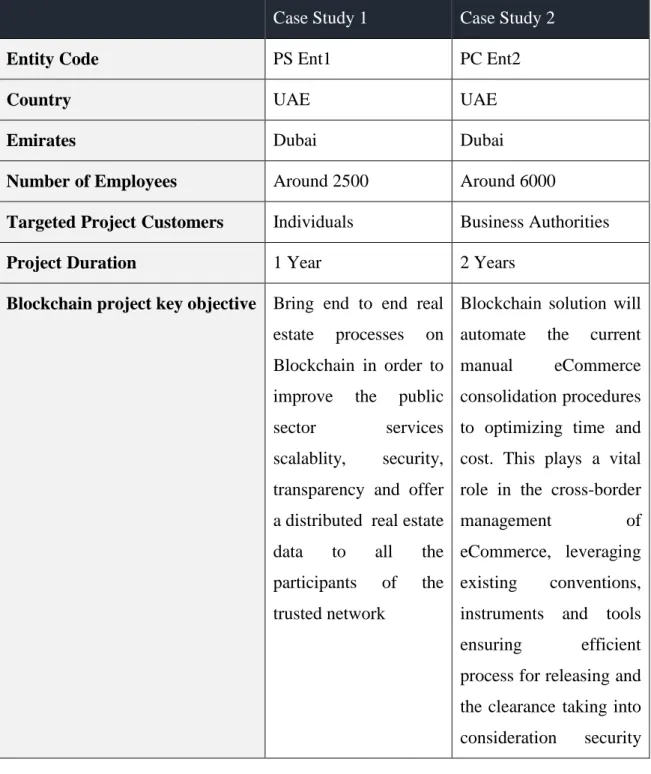
Data collection process
Data collection approach
Multiple sources of evidence
In-depth one-to-one interviews
The researcher aimed to interview at least one participant from each stakeholder group of the Blockchain project, to collect data from all project perspectives. Behrend (2005) argued that a total of 12 interviews is the lowest acceptable number of interviews to achieve acceptable information richness for any case study. Solution End User External/Internal Affected internal/external end user, who intends to use the delivered software.
Subject matter expert External expert in the field of software development, mainly Blockchain, that make it responsible to ensure.

Documentation
The collection of available rules and regulations is aligned with the research theory in this study, i.e. structuring. Specifically, when the researcher captured the available policy and strategic documentation, it created a clear understanding of the structure.
Case Study Protocol
Participants' perception of the extent to which social structure rules (eg policies, ICT strategy, procedures, etc.) have influenced and influenced the Blockchain implementation process. Problems and solutions Participants' perception of the approaches taken to identify existing problems and how the implementation of Blockchain technology was perceived as a solution to these problems. Stability Participant's perception of the role and contributions of each actor in the Blockchain project.
The participant's perception of the extent to which a roadmap developed by the IT department ensures the harmonized interactions of all actors with the new Blockchain system to achieve stability status.
Data analysis
However, before reducing the data, the researcher had revisited the codes and text categories to avoid redundancy. Finally, the researcher prepared the list of codes, classified into different categories, which can be considered as the broad units of information in qualitative research (Creswell 2013). And as discussed earlier, the researcher used research proposals informed by both: “ANT translation phases”.
At the end, the researcher developed a practical framework based on the selected theories that will guide the implementations of Distributed Ledgers by the public sector.
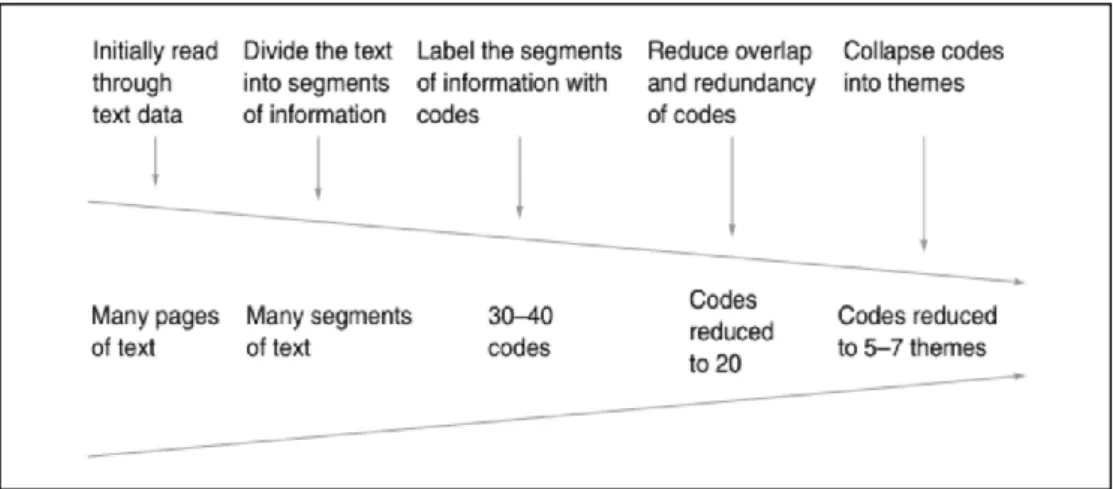
Research validity and reliability
To improve the transferability of research results, the researcher collected detailed descriptions of the phenomenon and contextual evidence (Shenton 2004). These actions by the researcher were intended to increase the applicability of findings in other situations. Finally, to improve the confirmability aspect, the researcher applied both ANT and structuring principles; this limits the role of the researcher during data collection.
Furthermore, the researcher followed and listened to the participants during the interviews without driving their answers.
Member Checking
In order to improve the credibility of the research, the researcher followed two practical steps: first, the researcher shared the interviews with the participants to check the accuracy of the transcriptions, in addition to answering any clarifications. In addition, the researcher conducted eight face-to-face interviews to collect observational data, but this practice was affected by the Covid-19 pandemic. Regarding the reliability of the study, the researcher provided clear explanations of the study process and consistency between all dimensions of the methods to be considered.
Social desirability bias
Peer Debriefing
Summary
CASE STUDY 1
Introduction
The selected public sector entity has been established mainly to ensure excellent service to all its clients and promote investment in Dubai real estate as well as spreading knowledge about the sector; this will help to propel the real estate industry in Dubai. Bring end-to-end real estate processes on Blockchain to improve the scalability, transparency, security and distribution of real estate data to all stakeholders of the trusted network. Moreover, the entity has decided to adopt a permissioned Blockchain network, so the entity still has some limit of control over the data held by the Blockchain nodes.
The accepted solution is offered to individual citizens to enable the management and automation of rental contracts for real estate.
Case Study Participants
NVivo coding
After that, the result of the report has been manually revised the highest relevant word frequency associated with the defined codes.
Findings of the Case Study
- First proposition: Findings
- Second Proposition: Findings
- Third Proposition : Findings
- Fourth Proposition: Findings
- Fifth Proposition : Findings
- Sixth Proposition : Findings
- Seventh Proposition: Findings
It was very important for the department to be able to develop the Blockchain roadmap and strategy. The above diagram shows the key approaches proposed and followed by the management and project stakeholders to achieve successful adoption of the Ejari Blockchain system. The fourth proposition developed for this study suggests that the Blockchain adoption project is influenced by the clarity of the problem and its solution.
Finally, defining stakeholder roles and responsibilities was one of the key aspects that influenced the Ejari Blockchain adoption project.
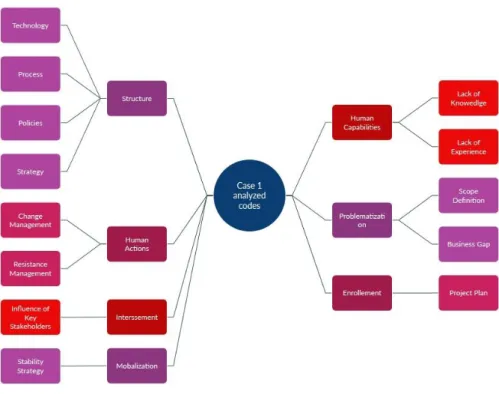
Summary
Fourth statement: Significant impact for the problem identification on the Blockchain adoption, mainly: scope definition and business gap identification. Fifth statement: Significant impact for the influence of key stakeholders on the Blockchain adoption, mainly: stakeholders. Sixth statement: Significant impact for the human roles on Blockchain adoption, mainly: developing a proper project plan with clear role and responsibilities of stakeholders.
Seventh proposition: Significant influence on the mobilization and stability of blockchain adoption, mainly: development of solution stability strategy.
CASE STUDY 2
Introduction
The main goal is to have about 50% of public sector services transferred and processed via Blockchain technology by 2021. Platform will enable digitization in a multi-party network that maintains a single version of the truth. This public entity was selected as a case study because this platform was mainly proposed in response to the continuous increase in the eCommerce related activities in the economy of the entire UAE country and the huge increase in the number of global eCommerce companies to be registered in Dubai .
The main concept of this platform is to allow every stakeholder involved in the eCommerce transaction to access the same data related to expedited shipping movements.
Case Study Participants
Solution Internal end user C2 end user Internal end user Partici36 External end user C2 External end user Partici37.
NVivo coding
Findings of the Case Study
- First Proposition: Findings
- Second Proposition: Findings
- Third Proposition : Findings
- Fourth Proposition: Findings
- Fifth Proposition: Findings
- Sixth Proposition: Findings
- Seventh Proposition: Findings
The features of Blockchain technology were one of the key drivers of the eCommerce Blockchain project. One of the key approaches the department has taken in adopting new technology is to follow a successful benchmark, and this has been done in the eCommerce Blockchain project. It is assumed by the fifth statement that the influence of the key project has an impact on the Blockchain project.
In conclusion, in this case, the stability strategy was one of the main risks of the project and well considered by the department to mitigate.
Summary
CROSS-CASE DISCUSSION OF FINDINGS
Introduction
Cross-Case discussion of Findings
- First Proposition: Findings
- Second Proposition: Findings
- Third Proposition: Findings
- Fourth Proposition: Findings
- Fifth Proposition: Findings
- Sixth Proposition: Findings
- Seventh Proposition: Findings
The first conceptual proposition for this study assumes that existing structural rules, procedures and policies influence the adoption of Blockchain technology in the public sector. The researcher identified from the two case studies that structural components have an impact on the Public Sector Blockchain project as summarized in Table F1 in Appendix F. Below Figure 44 shows the main findings for the four main structural components captured by the analysis of the two selected case studies, explaining how Blockchain adoption in the public sector is affected by the structure adopted in the first proposal of this study.
It is argued that Blockchain as a new technology offers several benefits to the public sector, for example: trust, transparency, etc.
Summary
CONCLUSION
Research Overview
Concluding Discussion
Limitations of the study
Research Contributions
Recommended Future Research
